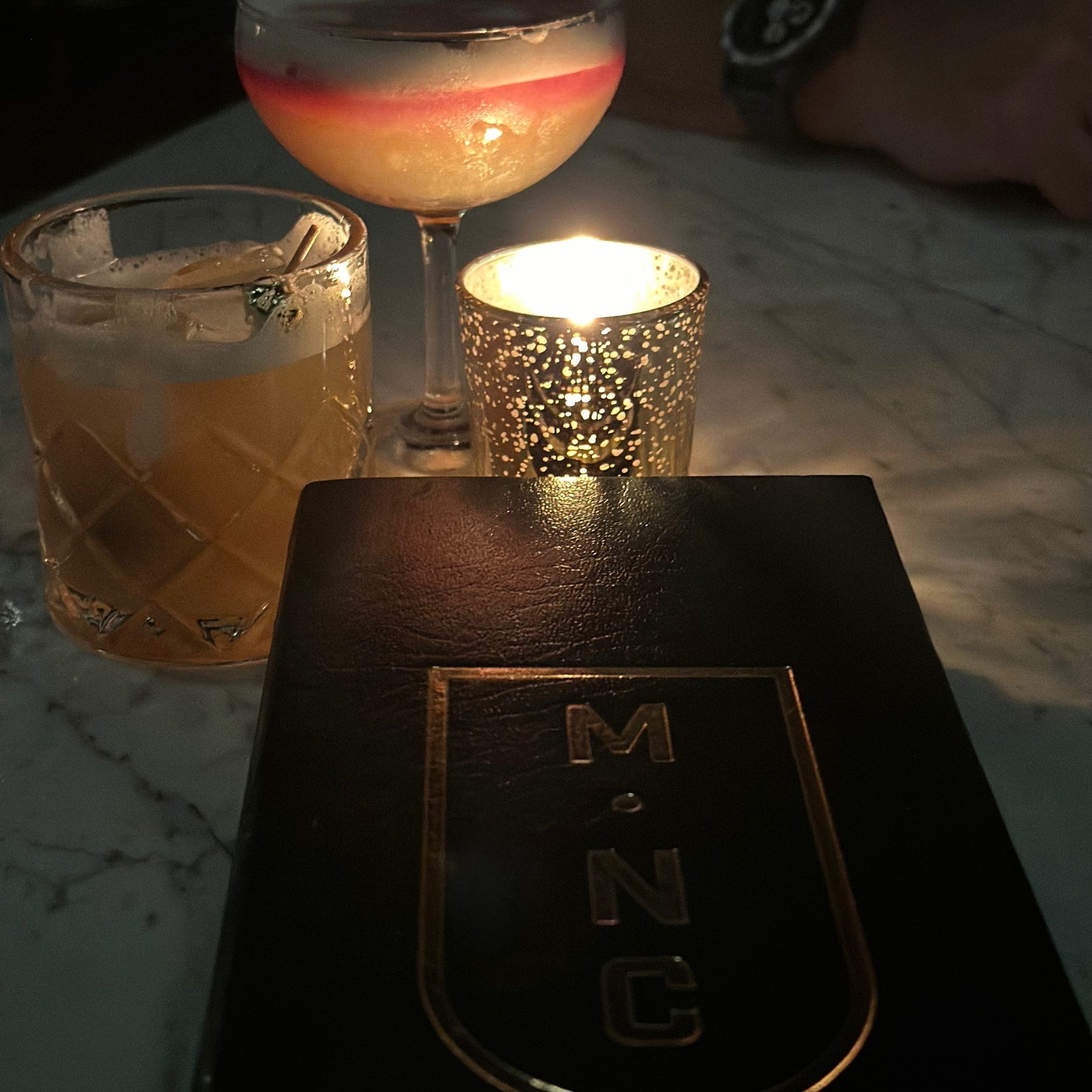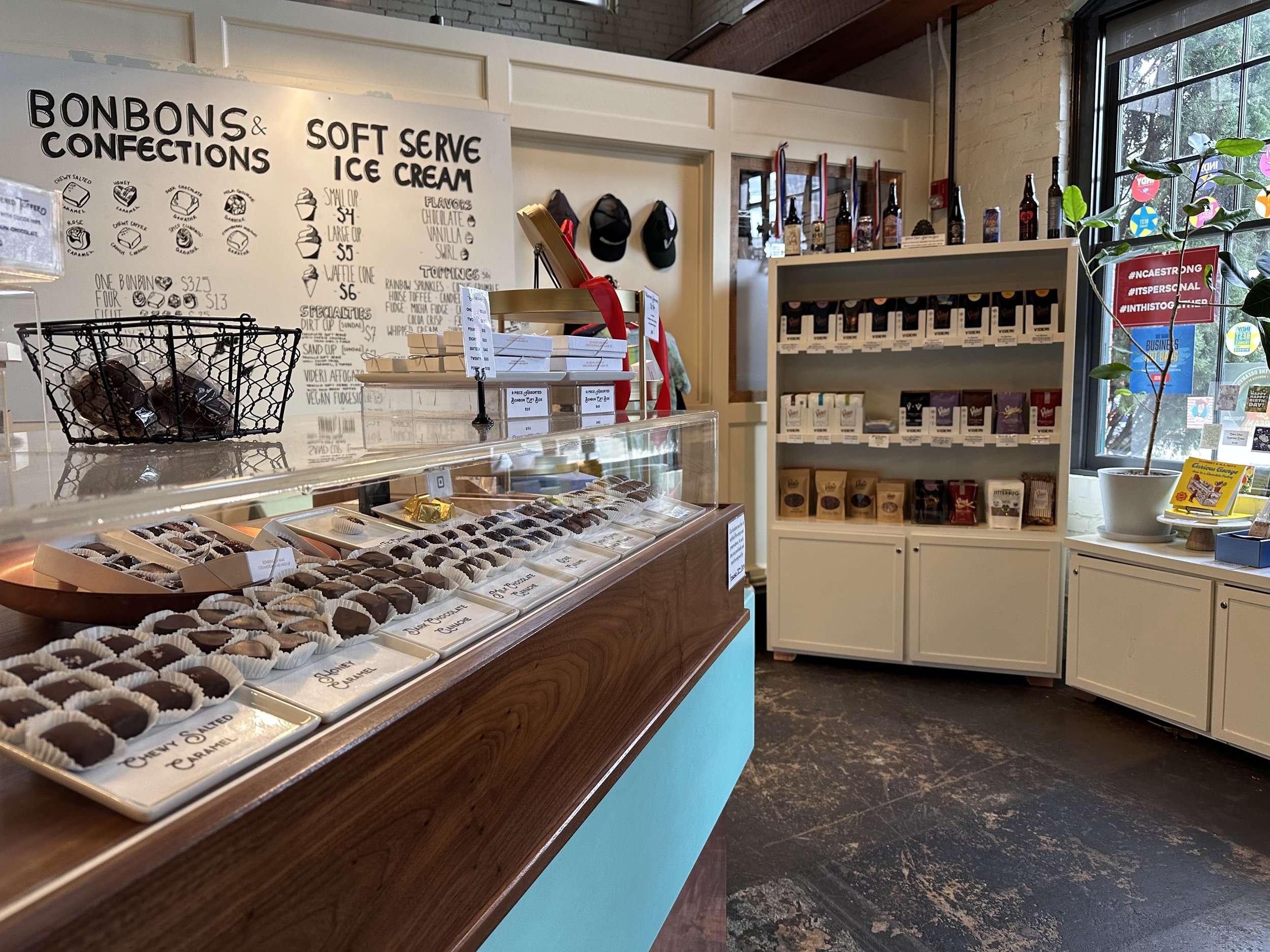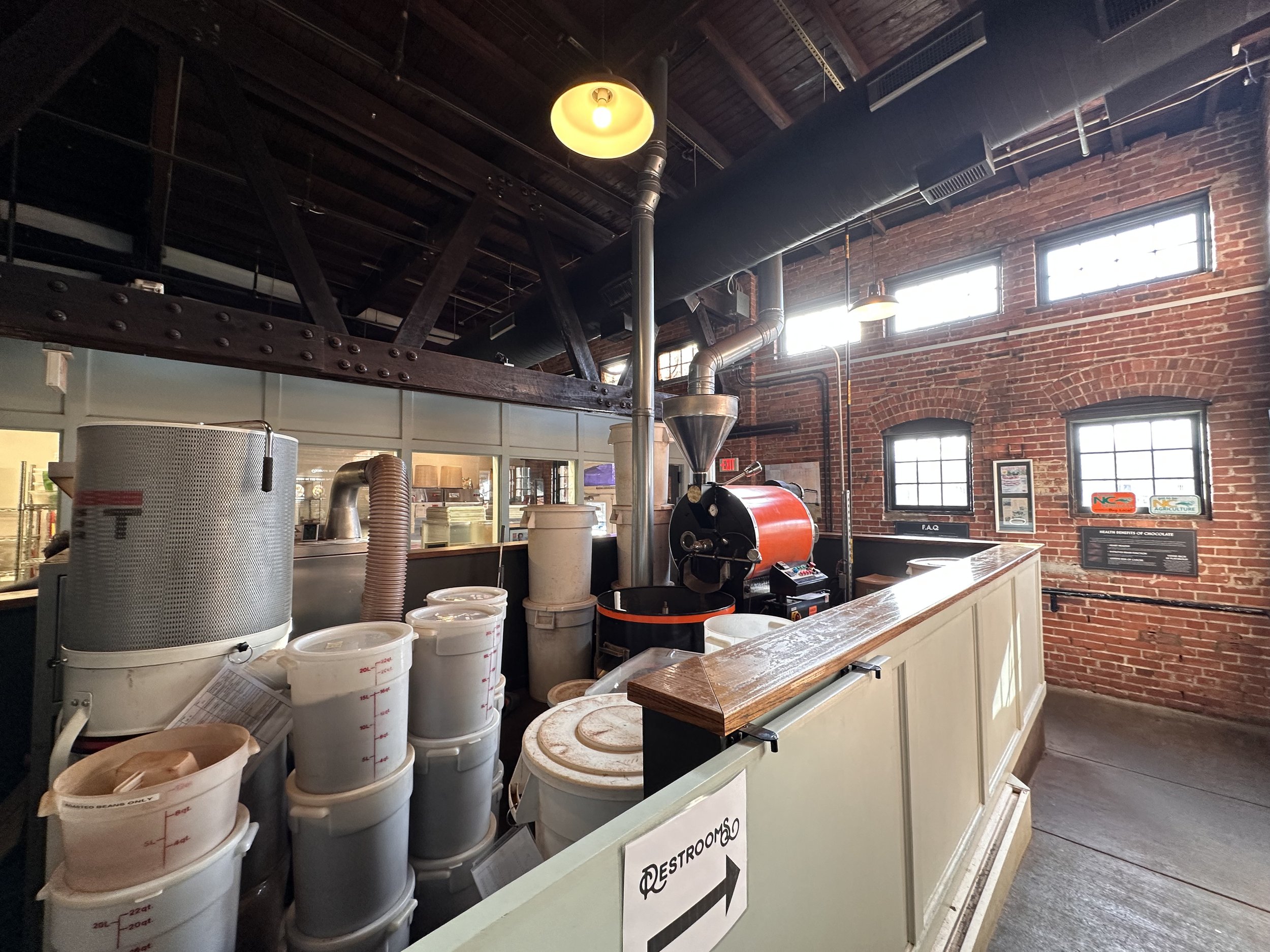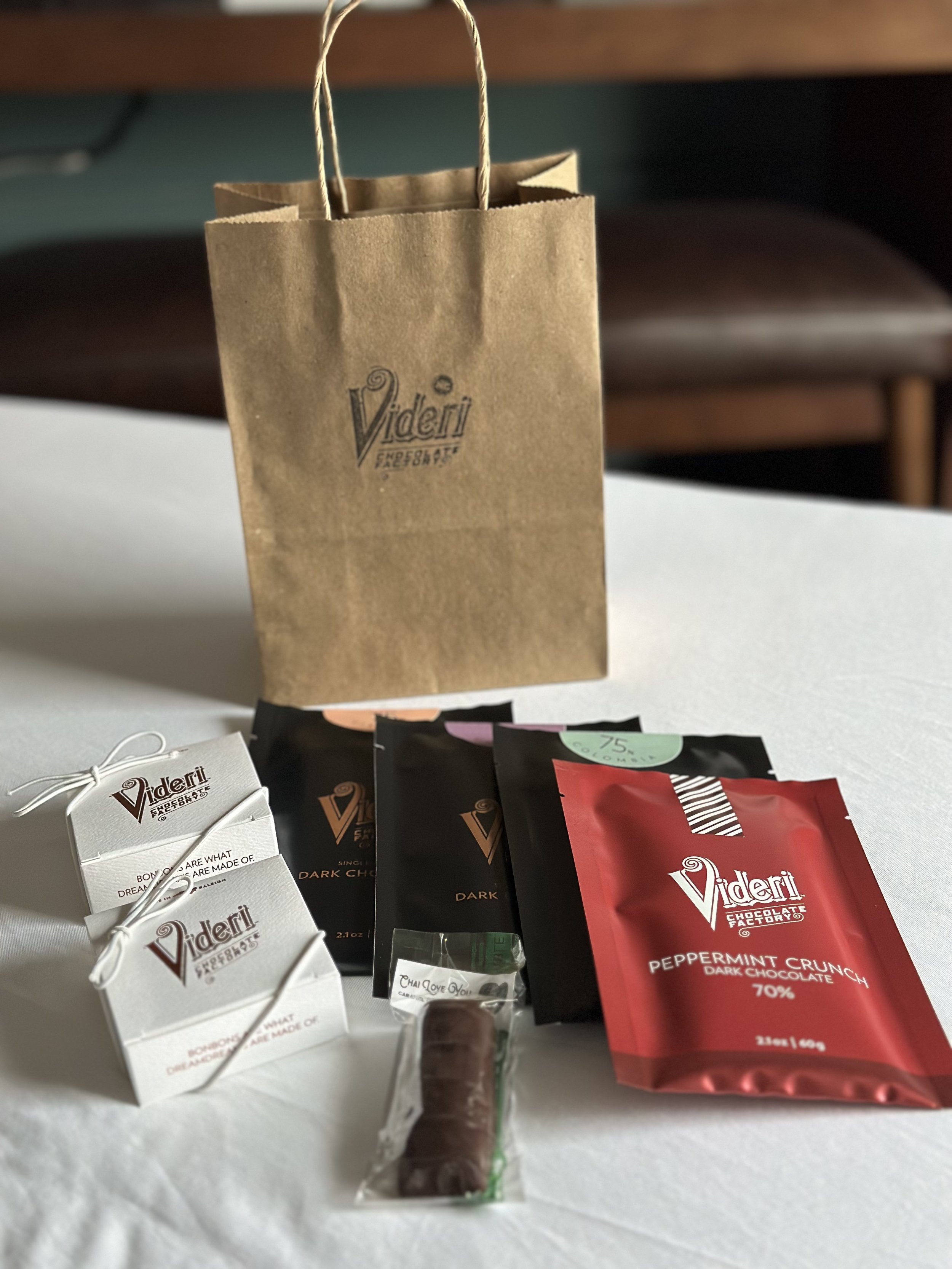Exploring Raleigh, NC
Time needed in this city: A weekend (2 nights)
Raleigh is a former heavy industrial city-turned “hipster’s paradise” with restaurants, coffee shops, breweries, and cocktail bars throughout. It made for a great weekend getaway that we can’t wait to visit again.
The below information is a complete guide of the best places to stay, the top rated places to dine and drink, and all there is to see and do. We’ve also included a summary of the history of this beautiful vibrant city!
Jump To:
Where to Stay
When we go to Raleigh, we stay at The Casso.
other recommendations
Heights House Hotel - one of the top-rate places to stay!
Where to Dine & Drink
A Place at the Table
Contemporary gathering place with a casual cafe menu, sidewalk seating & volunteer opportunities.
Atlantic Lounge (Speakeasy)
An underground speakeasy in Raleigh’s Oakwood neighborhood that is tucked into a space between Pelagic Beer and Wine bottle shop, and the restaurant, Crawford and Son. The nondescript entrance leads to a stairwell lit by the neon glow of a sign reading, “Don’t serious yourself to death.” A vintage Vacancy/No Vacancy sign, salvaged from an old hotel, acts as a sentry, letting patrons know if they can use their key to gain entry to the 44-seat bar.
How to get a key: The keys were initially offered to Oakwood residents, though they are accepting applications for additional key holders. Email theatlanticlounge@gmail.com to get started. The speakeasy is for the 25 and older crowd.
Aunty Betty's Gin and Absinthe Bar
Located inside the Morgan Street Food Hall.
Barcelona Wine Bar
Barcelona Wine Bar is a warm and welcoming tapas bar inspired by the culture of Spain. The ever-changing menu is focused on clean flavors, seasonal ingredients, specialties from Spain and the Mediterranean, and rustic small plate presentations created by chefs with tremendous talent. Barcelona offers an award-winning selection of wines from Spain and South America—and boasts one of the largest Spanish wine programs in the U.S.
Bida Monda
Hip, modern hideaway for Laotian fare & exotic cocktails in a slick, yet woodsy looking space.
Boulted Bread
Bright, rustic-chic bakery and stone mill, featuring pastries & loaves of bread made with local, organic grains.
Burger Village
Serving healthier, “exotic” burgers for allergy types and pallettes.
Carroll’s Kitchen
Housemade breakfast-&-lunch bites in a charity-run counter-serve benefiting women in crisis.
Crawford and Son
Dinner spot serving a curated menu of modern comfort plates, craft cocktails & drinking vinegars.
Death and Taxes
Inventive New American dishes & cocktails in an intimate, swanky setting with an open kitchen.
Dram & Draught
Per their website, “Our whiskey selection is vast featuring bottles from all over the world, along with a variety of choices in light and dark liquor. We’re always on the hunt for any kind of spirit that catches our eye. Our beer choices are handpicked by our knowledgeable team, ensuring a blend of local favorites and unique finds. For the wine lovers, our small but compelling wine list has something for everyone.
What really sets us apart is your experience inside our bar. Our knowledgeable team is all about ensuring you have a great time and helping you unwind from the daily grind in a place that feels like a second home.”
First Watch
Cafe chain for health-minded breakfast, brunch & lunch options such as omelets, salads & soups.
Irregardless
Long-running cafe offering a global menu of locally sourced fare, plus live music. TIP: Make a reservation at least a week in advance! We were lucky to get a spot at the bar,
Morgan Street Food Hall
Located in the Warehouse District, this food hall is home to 20-plus culinary concepts, including handcrafted burger spot, CowBar, Oak City Fish & Chips, and Curry in a Hurry.
Mustang House
A Nepalese and Indian restaurant serving lunch and dinner.
Oak Steakhouse
Contemporary establishment offering steaks, seafood, pasta & desserts amid a relaxed ambiance.
Oakwood Pizza Box
Casual, brick-clad eatery offering pizza with creative toppings plus coffee drinks & beers.
Poole’s
Circa-1945 diner with seasonal comfort food, cocktails & house desserts in a retro-chic setting. Their signature dish? Macaroni au Gratin. It’s made with grana padano, Jarlsberg, and white cheddar.
Second Empire Restaurant and Tavern
Located in the restored Dodd-Hinsdale House, built in the 1870s, the restaurant offers both a historical and gourmet dining experience, surrounded by Second Empire Victorian architecture.
SmokeStacks Cafe
SmokeStacks Cafe is a family-owned restaurant, located in the heart of the Historic Oakwood Neighborhood in Downtown Raleigh NC. Specializing in craft smoked meats, SmokeStacks is not your typical BBQ, "meat and three sides," spot.
Stanbury
Hip, rustic venue for creative, seasonal New American small plates & entrees, plus craft cocktails. It’s one of the top spots in Raleigh!
Tamasha
Per their site, “Epitomizing the essence of high-end dining, Tamasha Modern Indian is on a mission to reignite the allure of Indian cuisine with a contemporary flair. This unique, stylish, and modern Indian restaurant offers patrons not just a meal, but a vibrant sensory journey into the realm of modern Indian cuisine, complemented by a lively and spirited atmosphere.”
Taverna Agora Greek Kitchen and Bar
Casual, warm mainstay with a homey feel & a rooftop patio offering Greek & other Mediterranean eats.
The Angus Barn
Sprawling upscale steakhouse in a barn-like setting with an opulent wine cellar, lounge & cigar bar.
TIP: Make a reservation a month in advance of the Christmas season, which is the ultimate time to go!
The Blind Barbour (Speakeasy)
Once you enter through the barbershop, a hidden bar awaits you, complete with a DJ, cocktails and small bites.
The Merchant (Speakeasy)
If you look hard enough while walking along Salisbury Street in downtown Raleigh, you might spot a vintage secret door. The cocktail menu is great with some wonderful absinthe drinks (if that’s your thing).
The Parlor
Located in the Heights House Hotel (a restored Italianate mansion from the 1800s) people come just to sip on cocktails in the fully restored bar area.
Transfer Co. Food Hall
50,000 square feet of vendors, makers, restauranteurs, and more, inside the historic Carolina Coach Garage and Shops
Watts & Ward (Speakeasy)
It’s a members-only club, so you have to either know a member or become a member yourself to enter.
Things to See & Do
Cameron Village Shopping Center
Since 1949, Cameron Village shopping center has been home to stores and restaurants alike, and is the oldest shopping center in the Southeast. Today, over 90 brands of shops and restaurants are tucked away in this village.
City Market
City Market was founded in October, 1914. It became known as a historic place when Raleigh City Council secured a grant from the North Carolina Division of Archives & History to study the architectural resources surrounding Moore Square, in 1980. Today, it is one of the major tourist attractions in Raleigh.
The market hosts a monthly festival, called First Friday, on the first Friday of every month.
Contemporary Art Museum (CAM)
Per their website, “CAM Raleigh is a non-collecting contemporary art museum that provides an environment for transformation through educational programs, cultural experiences, and bold, non-traditional exhibitions by living artists.”
Frankie’s of Raleigh
Looking for something to do with the kids (even the big kids) for an afternoon? Frankie’s is an indoor/outdoor amusement park, which includes rides, mini golf, go-karting, arcade games and more.
Haywood Hall House
Built in 1792, Haywood Hall is a two-story, five-bay, Federal-style frame dwelling with a central hall plan. It features a two-story front porch with attenuated fluted Doric order columns. It was the home of North Carolina State Treasurer, John Haywood, and is now open as a historic museum. It was listed on the National Register of Historic Places in 1970.
Historic Oakwood
Historic Oakwood is a neighborhood in downtown Raleigh, on the National Register of Historic Places (since 1974), and known for its Historic Oakwood Cemetery, its many Victorian houses, and its location close to the Mordecai Plantation Manor.
Located near the State Capitol and St. Augustine's Chapel, during the 19th century, Historic Oakwood was home to prominent members of Raleigh's society. It is North Carolina's largest, intact 19th Century residential neighborhood and Raleigh's earliest white middle-class suburb. Unlike later suburbs, it developed lot-by-lot over time, instead of by platted sections. Its Victorian-era architectural styles include Second Empire, Queen Anne, and Italianate. Later infill brought the bungalow, the American Foursquare, American Craftsman style, and the Minimal Traditional house to the area.
Oakwood is also known for its Christmas Candlelight Tour, which opens private historic residences to the public, as well as the Garden Tour, which allows the public to see the vast gardens worked on by the Oakwood Gardening Club.
Joel Lane Museum House
The Joel Lane House was built in 1769 and is now a restored historic home and museum. It is the oldest dwelling in Wake County and contains collections of 18th century artifacts and period furnishings. The museum grounds include a detached middle-class home, built circa 1790, a formal city garden, and a period herb garden. The house is named after Joel Lane, the "Father of Raleigh" and "Father of Wake County."
Martin Marietta Center For The Performing Arts
The Martin Marietta Center for the Performing Arts hosts national tours and performers, and is also home to five resident companies; Carolina Ballet, NC Opera, NC Symphony, NC Theatre, and PineCone. Hosting over 600 events each year and welcoming over 400,000 guests, the Martin Marietta Center is a cultural focal point in downtown Raleigh.
Mordecai Historic Park
Built in 1785, the Mordecai House is a registered historical landmark and museum that is the centerpiece of Mordecai Historic Park, adjacent to the Historic Oakwood neighborhood. It is the oldest residence in Raleigh on its original foundation. In addition to the house, the Park includes the birthplace and childhood home of President Andrew Johnson, the Ellen Mordecai Garden, the Badger-Iredell Law Office, Allen Kitchen, and St. Mark's Chapel, a popular site for weddings. It is located in the Mordecai Place Historic District.
It’s Haunted!
The Mordecai House is locally known for its paranormal activity and is believed to be the most haunted house in Raleigh. It was featured in a season two episode of Ghost Hunters in which the TAPS team investigated some of those claims. In addition, Mordecai Historic Park has an exclusive paranormal research team, The Ghost Guild Inc., since 2017, and is a registered nonprofit organization that investigates the house and its surrounding buildings at least three times per year.
Visitors and workers have reported seeing a woman wearing a long black skirt, white blouse and a black tie moving quietly through the hallways. It has been rumored that she can sometimes be seen standing on the balcony if you pass by late at night. In recent years, visitors have recounted hearing a piano playing.
North Carolina Executive Mansion
The North Carolina Executive Mansion (also referred to as the North Carolina Governor's Mansion) is the official residence of the governor of North Carolina and their family. Building began in the year 1883 and was designed by architects, Samuel Sloan and A.G. Bauer. The first occupants, Governor Daniel G. Fowle and his daughter, Helen Whitaker Fowle, moved into the unfinished building in January 1891. It is an example of Queen Anne style architecture.
North carolina Museum of Art (NCMA)
The North Carolina Museum of Art (NCMA) opened in 1956 as the first major museum collection in the country to be formed by state legislation and funding. Since the initial 1947 appropriation that established its collection, the Museum has continued to be a model of enlightened public policy with free admission to the permanent collection. Today, it encompasses a collection that spans more than 5,000 years of artistic work, from antiquity to the present, an amphitheater for outdoor performances, and a variety of celebrated exhibitions and public programs. The Museum features over 40 galleries, as well as more than a dozen major works of art in the nation's largest museum park with 164-acres.
Cloud Chamber for the Trees and Sky
The short, round hut, known as “The Cloud Chamber for the Trees and Sky” looks like a hobbit’s home but it is actually the work of British artist, Chris Drury, who built the structure for an optical illusion of sorts.
Located behind the North Carolina Museum of Art, the Cloud Chamber is a unique work that mixes a sort of fairytale design with almost medieval-like technology. The hut, itself, is made of large stone blocks in the shape of an igloo with green turf sitting on top. On the inside, the only light in the chamber comes from a single small hole in the roof of the chamber, which acts as a small “lens” - a medieval optics trick that projects a mirror image of the area on the lit side of the camera. Thus, the interior of the cloud chamber has trees, clouds, and blue sky projected across the white cement walls.
Ultimately, this chamber allows visitors to virtually walk among the clouds and the treetops using a technology that requires nothing but sunshine.
HOW TO GET THERE: The chamber is located in the NCMA's Ann and Jim Goodnight Museum Park. After parking in the nearby lot, take the trail down into the field, cross the stream, and continue on up into the woods until you see it. If you're lost, just take a look at one of the maps posted in the park.
North Carolina Museum of History
The North Carolina Museum of History showcases more than 14,000 years and 150,000 artifacts of N.C. history, from native inhabitants to the 20th century. Dozens of exhibits are on display focusing on a variety of eras in state history, and there are always new exhibits to come and visit.
The museum’s permanent exhibit, The Story of North Carolina, holds amazing artifacts, multimedia presentations, dioramas and interactive features, along with two, full-size historic houses and many recreated environments. Notable artifacts include recovered items from the Queen Anne’s Revenge, Civil War flags and weapons, a replica of the 1903 Wright Flyer, and a lunch counter from a 1960 Salisbury, N.C., sit-in during the American civil rights movement.
North Carolina Museum of Natural Sciences
The Southeast’s largest natural history museum has four floors of exhibits, live animals, 3D movies, three gift stores, and two cafes. The iconic 70-foot-diameter globe at its center houses a three-story theater with live programming and ambient movies on its giant screen. Visitors can observe scientists at work in five glass-walled research labs, and in three Investigate Labs, they can perform experiments designed and led by museum educators.
Exhibits include the world’s most complete Acrocanthosaurus dinosaur; a juvenile T. rex; six great whales; a 10,000-gallon aquarium; a two-story waterfall; walk-through dioramas; a Naturalist Center with real specimens; a vet window where visitors can watch live procedures and talk to the staff; and a butterfly room that also houses a two-toed sloth.
Oak Wood Cemetery
Historic Oakwood Cemetery was founded in 1869 in the historic Oakwood neighborhood. The cemetery contains two special areas within its 102 acres - the Confederate Cemetery, located on the original 2 1/2 acres, and the Hebrew Cemetery, both given for that purpose by Henry Mordecai in 1867.
Among the many beautiful monuments and statuary within the cemetery are those of seven governors, five United States Senators, eight Supreme Court Chief Justices of North Carolina, four Civil War generals, two Secretaries of the United States Navy, numerous Raleigh mayors, and local citizens.
Pine State Creamery Butter Churn
The Pine State Creamery was formed at the behest of the State College Agricultural Extension Service, which encouraged the establishment of dairy cooperatives after World War I. This creamery in Raleigh created 400 jobs and produced 9.4 million gallons of milk annually, supplying half the state’s school systems’ cafeteria milk. But after top creamery officials pleaded guilty in 1991 to felony charges in a state-wide bid-rigging scheme (the Creamery had overcharged hundreds of thousands of schoolchildren for milk throughout the 1980s), Pine State suffered heavy fines and eventually succumbed to bankruptcy in 1995.
Today, the official city historical landmark is now an office complex that is home to a steakhouse, a boxing gym, and a Mexican restaurant, though it’s still adorned with a 20-foot-tall cement butter churn.
Pope House Museum
Built in 1901, the Pope House Museum is a restored home once owned by Dr. Manassa Thomas Pope, a prominent African-American citizen of Raleigh. The Pope House is listed on the National Register of Historic Places, since 1999, It is now open for tours.
Pullen Park
Pullen Park was founded on March 22, 1887, when Richard Stanhope Pullen of Pullen Plantation donated farmland to the City of Raleigh expressly to be used as a space for recreational enjoyment of its citizens and visitors. This land became Pullen Park, the first public park in North Carolina. A "Committee on Public Parks" was formed to oversee the transformation and aPark Keeper was hired in 1888 to oversee these modifications. Pullen continued his own involvement by taking part in the planning and financing of bridges, roads, and paths throughout the park, as well as the planting of trees and general landscaping in the park and the neighboring NC State University, which was built on land also donated by him. He also financed a round pavilion for outdoor entertainment and a fountain, located near the city's first swimming pool (for men only) in 1891. A congressman from another county donated 50 Japanese carp for the fountain, which shows the significance of the park. In 1895, modifications to the structure and regulations of the pool allowed for its use by women. The pool remained in the same place until it was replaced by the Pullen Aquatic Center in 1992.
In addition to the many attractions in the park today, there was also a small zoo on site from 1899 to 1938. The park's original steam-powered merry-go-round was replaced by the current carousel in 1921. The zoo was created following a national trend to incorporate zoological parks in public parks, which began in 1875. Beginning with only two raccoons, the collection soon grew in size and variety and by 1903, included an Australian owl, mink, bears, alligators and monkeys and many other species. The zoo eventually closed, due to the death of the Park Keeper.
In 2000, the city began making plans to update the park to accommodate Raleigh's growing population and later invited the citizens to take part in the plans. Over the past several years many changes have been made, including the removal of an iconic 'Swiss cheese' play structure and other playground equipment. More notable, however, is the new entrance and additional parking that make the park more accessible to more people.
According to the census of the National Amusement Park Historical Association, Pullen Park is the 14th oldest amusement park in the world.
Raleigh Market
For more than 50 years, the flea market at the State Fairgrounds has offered one of the most unique and entertaining shopping experiences in the state. Each weekend, hundreds of indoor and outdoor vendors showcase an incredible range of items, from high-end antiques, to power tools, and everything in between. A rotating array of food trucks, fair food, and farm stands are also on site.
Videri Chocolate Factory
Housed in the historic downtown Raleigh Depot building in the Warehouse District, Videri Chocolate Factory is crafting chocolate in the heart of the City of Oaks. It offers guests a true bean-to-bar experience with self-guided tours available any time. Upon entering, look for the posted signs throughout the factory so you can easily read your way through the whole chocolate-making process.
NOTE: We recommend any and all chocolate they sell, along with a coffee soda. Make sure to ask for a syrup and/or whipped cream on top!
Yates Mill County Park
Yates Mill is a fully restored, circa 1756 gristmill, located five miles south of downtown Raleigh.
The park features the restored mill, a visitor center with a museum, focused on milling and on the natural history of the area, classrooms, an auditorium, and space for research conducted by North Carolina State University faculty and students. There’s also a 20-acre lake and extensive hiking trails.
Zipline Mini Golf
A History Summary
1788 - Raleigh was chosen as the site of the new capital as its central location protected it from attacks from the coast.
1792 - It was officially established as both county seat and state capital. The city was incorporated on December 31, 1792.
1795 - A charter granted and the city was named for Sir Walter Raleigh, sponsor of Roanoke, the "lost colony" on Roanoke Island.
1799 - The N.C. Minerva and Raleigh Advertiser was the first newspaper published in Raleigh.
1808 - Andrew Johnson, the United States' future 17th President, was born at Casso's Inn in Raleigh.
1818 - The city's first water supply network was completed although due to system failures, the project was abandoned.
1819-1821 - Raleigh's first volunteer fire company was founded, followed in 1821 by a full-time fire company.
1831 - A fire destroyed the North Carolina State House. Two years later, reconstruction began with quarried gneiss being delivered by the first railroad in the state.
1840 - Raleigh celebrated the completion of the new State Capitol and new Raleigh & Gaston Railroad Company.
1861 - North Carolina seceded from the Union during the American Civil War on May 20, 1861.
1877 - The North Carolina College of Agriculture and Mechanic Arts, now known as North Carolina State University, was founded as a land-grant college.
1889 - The city's Rex Hospital opened
1912 - Bloomsbury Park opened, featuring a popular carousel ride. Relocated to Pullen Park, the Pullen Park Carousel is still operating.
1922 - 1927 - In 1922, WLAC signed on as the city's first radio station, but lasted only two years. WFBQ signed on in 1924 and became WPTF in 1927. It is now Raleigh's oldest continuous radio broadcaster.
1923 - 1927 - In 1923, the Raleigh Fall Festival was formed. The Festival was reorganized as the North Carolina Debutante Ball in 1927.
1929 - The city's first airport, Curtiss-Wright Flying Field, opened in 1929. That same year, the stock market crash resulted in six Raleigh banks closing.
1932 - In 1932, Raleigh Memorial Auditorium was dedicated and the North Carolina Symphony was founded.
1934 to 1937 - The federal Civilian Conservation Corps constructed the area now known as William B. Umstead State Park.
1939 - 1943 - The State General Assembly chartered the Raleigh-Durham Aeronautical Authority to build a larger airport between Raleigh and Durham, with the first flight occurring in 1943.
1953 - WNAO-TV, channel 28, became the city's first television station, though it folded in 1957.
1977 - The first Raleigh Convention Center (replaced in 2008) and Fayetteville Street Mall were both opened in 1977. Fayetteville Street was turned into a pedestrian-only street in an effort to help the then-ailing downtown area, but the plan was flawed and business declined for years to come. Fayetteville Street was reopened in 2007 as the main thoroughfare of Raleigh's downtown. It joined the historic district in 2008.
1996 - WRAL-TV became the first High-Definition broadcast station in the world.
2017 - On July 26, 2017, the Catholic Diocese of Raleigh dedicated its new cathedral, Holy Name of Jesus Cathedral, the fifth-largest in the United States.






